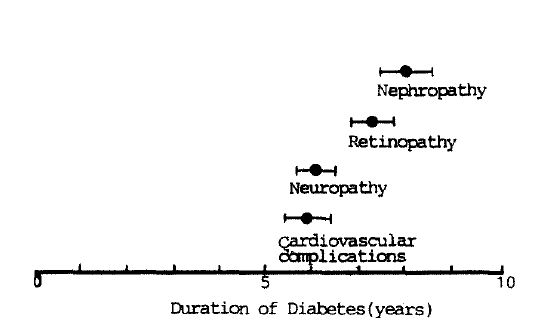1. Boulton AJM, Scarpello JHB, Martin TRP, Pilling D, Ward JD. Claudication in neuropathic with supra-normal pressure indices. Diabetologia 20:666. 1981.
2. Ward JD. The diabetic leg. Diabetologia 22:141ŌĆō471982.


3. Tsai SJ. Diabetes Mellitus in Asia. Proceedings of the Second Symposium, Kyoto 1975. In: Baba S, Goto Y, Fukui I, eds. ICS 390. Excerpta Medica, Amsterdam: 69ŌĆō731975.
4. Ellenberg M. Diabetic neuropathy. In: Ellenberg M, Rifkin H, eds. Diabetes Mellitus Theory and Practice. 3rd ed. New Hyde Park, New York: Medical Examination Publishing Co, 777ŌĆō8011983.
5. Piratt J. Diabetic neuropathy: a metabolic or a vascular disease? Diabetes 14:1ŌĆō91965.


6. Piratt J. Diabetes mellitus and its degenerative complications: a prospective study of 4,400 patients between 1947 and 1973. Diabetes Care 1:168ŌĆō88252ŌĆō631978.

7. Tiengo A, Segatoi T, Briani G, Setti A, Del-Prato S, Devide A, Padovan D, Virgili F, ad Crepaldi G. The presence of retinopathy in patients with secondary diabetes following pancreatectomy or chronic pancreatitis. Diabetes Care 6:570ŌĆō741983.


8. Leibowita. The Framingham Eye Study. V Diabetic retinopathy. Surv Ophthalmol 24(Suppl.):MayŌĆōJune. 401. 1980.
9. Mitchell P. The prevalence of diabetic retinopathy: A study of 1300 diabetics from Newcastle and the Hunter Valley. Aust J Ophthalmol 8:241. 1980.


10. Couet C, Genton P, Pointel JP, Louis J, Gross P, Saudax E, Debry G, Drouin P. The prevalence of retinopathy is similar in Diabetes Mellitus secondary to chronic pancreatitis with or without pancreatectomy and in idiopathic Diabetes Mellitus. Diabetes Care 8:323ŌĆō281985.


11. Miki E, Kuzuja T, Ide T. Frequency, degree, and progression with time of proteinuria in diabetic patients. Lancet 1:922. 1972.


12. Klimt CR, Knatterud GL, Meinert CL, Prout TE. The University Group Diabetes Program: A study of the effects of hypoglycemic agents on vascular complications in patients with adult-onset diabetes. I. Design, methods and baseline characteristics. Diabetes 19(Suppl 2):747. 1970.
13. Knatterud GL, Klimt CR, Goldner MG. The University Group Diabetes Program. Effects of hypoglycemic agents on vascular complications with adult-onset diabetes. VIII. Evaluation of insulin therapy: Final report. Diabetes 31(Suppl 5):1. 1982.

14. Light G, Barker CO, Wilber JA. Diabetic nephropathy-Georgia. MMWR 30:296. 1981.

15. Easterling RE. Racial factors in the incidence and causation of end-stage renal disease. Trans Soc Artif Intern Organs 23:28. 1977.

16. West KM, Erdreich LJ, Stober JA. A detailed study of risk factors for retinopathy and nephropathy in diabetes. Diabetes 29:501. 1980.


17. Kamenetzky SA, Bennett PH, Dippe SE. A clinical and histologic study of diabetic nephropathy in the Pima Indians. Diabetes 23:61. 1974.


18. Krolewski AS, Warram JH, Christstlieb Ar. Onset, course complications, and prognosis of diabetes mellitus in JoslinŌĆÖs Diabetes Mellitus. VII ed. In: Marble A, Krall LP, Bradley RF, Christileb AP, Soeldner JS, eds. Philadelphia: Lea and Febiger, 251ŌĆō2771985.
19. Jarrett RJ, Keen H, Chakrabarti R. Diabetes hyperglycemia and arterial disease. In: Keen H, Jarrett RJ, eds. Complications of diabetes. 2nd ed. Arnold, London: 179ŌĆō1841982.
20. West KM. Epidemiology of diabetes and its vascular lesions. Elsevier, New York: 353ŌĆō3691978.
21. Entmacher PS, Krall LP, Kranczer SN. Diabetes mortality from vital statistics. In: Marble A, Krall LP, Bradley RF, Christlieb AR, Soeldner JS, eds. JoslinŌĆÖs Diabetes Mellitus. VII ed. Philadelphia: Lea and Febiger, 278ŌĆō2971985.
22. Okuno G, Tako H, Fukuda K, Okamoto K, Kashihara T, Takenaka H, Toda Y. Diabetes Mellitus in Asia Proceedings of the second Symposium, Kyoto, 1875. In: Baba S, Goto Y, Fukui I, eds. ICS 390. Excerpta Medica, Amsterdam: 183ŌĆō1881975.
23. Fernand RE. Diabetes Mellitus in Asia. Proceedings of the Second Symposium, Kyoto 1975. In: Baba S, Goto Y, Fukui I, eds. ICS 390. Excerpta Medica, Amsterdam: 98ŌĆō1081975.
24. Young RTT, Warg CCL, Chan LKF. Diabetes Mellitus in Asia. Proceedings of Second Symposium, Kyoto 1975. In: Baba S, Goto Y, Fukui I, eds. ICS 390. Excerpta Medica, Amsterdam: 131ŌĆō1361975.
25. Sukono , Soewignjo S, Suharto In. Diabetes Mellitus in Asia. Proceedings of the Second Symposium, Kyoto 1975. In: Baba S, Goto Y, Fukui I, eds. ICS 390. Excerpta Medica, Amsterdam: 196ŌĆō2011975.
26. Baba S, Doi K, Morita S, Ikuno T, Yoshida Y, Morita S, Yokono K, Imamura Y, Taniguchi H. Diabetes Mellitus in Asia. Proceedings of the Third Symposium Honolulu, 1981. In: Melish JS, Hanna J, Baba S, eds. ICS 549. Excerpta medica, Amsterdam-Oxford-Princeton: 77ŌĆō871982.
27. Yeung RTT, Wang CST, Kwan S. Diabetes Mellitus in Asia. Proceedings of the Third Symposium Honolulu, 1981. In: Melish JS, Hanna J, Baba S, eds. ICS 549. Excerpta Medica, Amsterdam-Oxford-Princeton: 277ŌĆō2811982.











 PDF Links
PDF Links PubReader
PubReader ePub Link
ePub Link Full text via DOI
Full text via DOI Download Citation
Download Citation Print
Print


